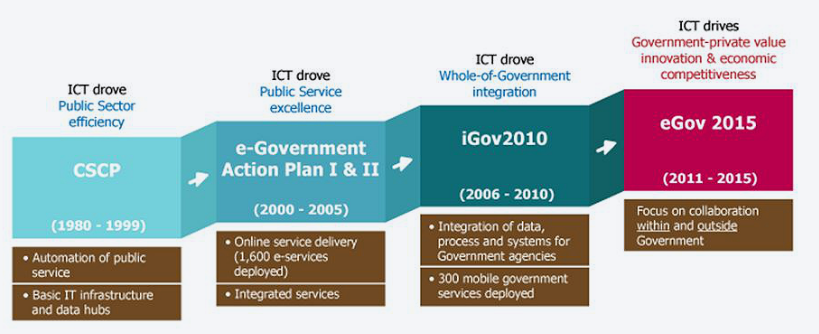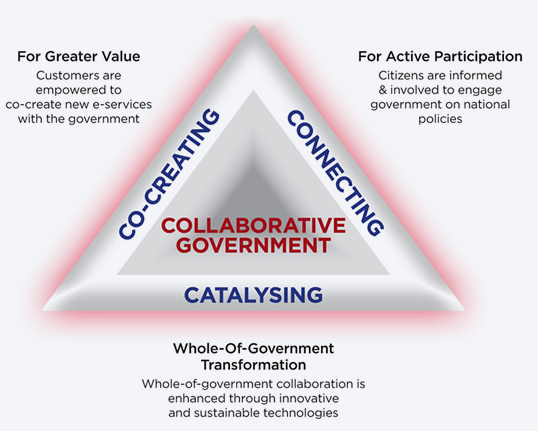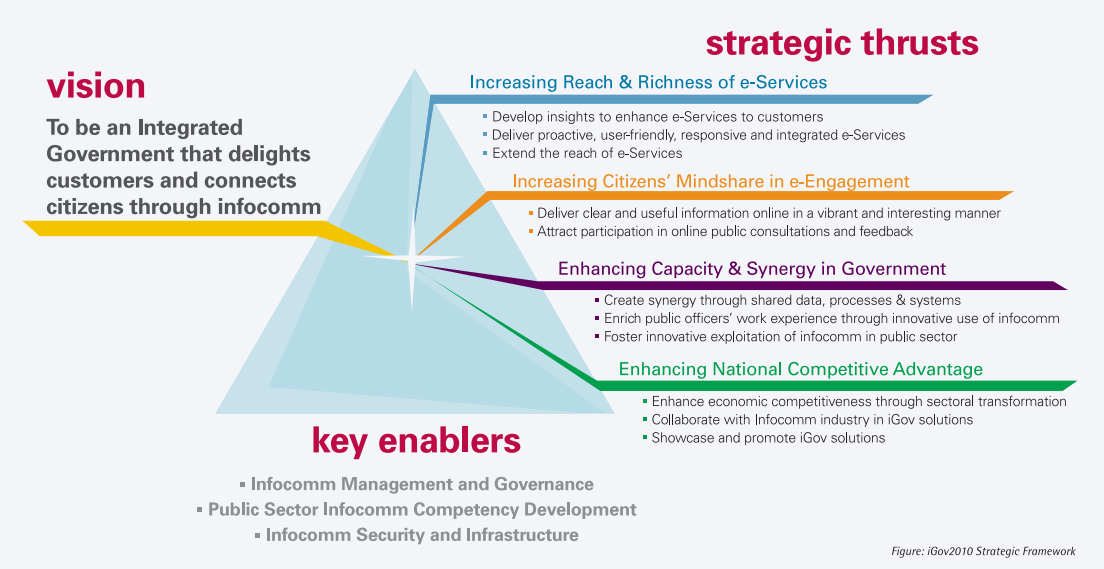eGov Masterplans

The eGovernment Masterplans set the tone and direction of digital governance technologies over a set period of time. There have been five eGov Masterplans so far: Civil Service Computerisation Programme, eGAP I (2000 – 2003), eGAP II (2003 – 2005), iGov 2010 and eGov 2015.
eGov 2015 (2011 – 2015)

The focus of eGov 2015 shifted the delivery of Government e-services from a top-down “Government-to-You” system to a “Government-with-You” approach. This approach encouraged greater co-creation and interaction between the Government, citizens and private sector to create better solutions for the country and its people.
Full scope of eGov 15’s Strategic Thrusts are:
-
Co-creating for greater value (Government as a service provider/Government as a platform provider)
-
Connecting for active participation (Consulting the public/Inviting Ideas from the public)
-
Catalysing Whole-of-Government transformation (Transforming public sector infrastructure and services through G-Cloud and SGEA/Transforming public sector workplace and capabilities)
Full detailed PDF of the eGov2015 publication.
iGov 2010 (2006 – 2010)

iGov 2010’s primary goal was to achieve a more integrated government through the use of infocomm technology. In order to achieve this, backend processes were integrated across agencies, allowing them to provide a more customer-friendly service delivery. Efforts were made to develop insights into the needs and preferences of the customers, and to anticipate their needs in order to increase the richness of e-Services. The reach of e-services was also extended, with steps taken to provide citizens lacking in access to the Internet with the facilities to do so.
Full scope of iGov 10’s Strategic Thrusts are:
-
Increasing reach and richness of e-Services
-
Increasing citizens’ mindshare in e-engagement
-
Enhancing capacity and synergy in government
-
Enhancing national competitive advantage
Full detailed PDF of the iGov 2010 publication.
e-Government Action Plan II/eGAP II (2003 – 2006)
eGAP II set out to achieve a networked government that is able to deliver accessible, integrated and value-added e-services to the country’s customers, and in turn, help bring citizens closer together.
Full scope of eGAP II’s Strategic Thrusts are:
Delighted Customers (Increasing awareness of e-services and convenient access for all/Improving the e-service experience)
Connected Citizens (Engaging citizens through active consultation and virtual communities)
Networked Government (Transcending organisation boundaries)
Full detailed PDF of the eGap II publication.
e-Government Action Plan II/eGAP I (2000 – 2003)
eGAP I’s purpose was to make Singapore a leading e-Government in an increasingly digital world economy. To achieve this, eGAP I was centred on these strategic thrusts:
-
Re-inventing government in the digital economy (Delivering integrated electronic services)
-
Delivering integrated electronic services
-
Being proactive and responsive
-
Using ICT to build new capabilities and capacities
-
Innovating with ICT
Full detailed PDF of the eGap I publication.
Civil Service Computerisation Programme (1980 – 1999)
The Civil Service Computerisation Programme (CSCP) was started with a focus to improve public administration through the effective use of ICT. The early days of the programme were primarily simple processes that would improve efficiency, such automating work functions and reducing paperwork. Over time, data was converted to digital formats, by the turn of the early 90s, emphasis shifted towards the consolidation of computing resources into the form of a shared data centre and a civil service-wide network.
https://www.tech.gov.sg/media/corporate-publications/egov-masterplans
